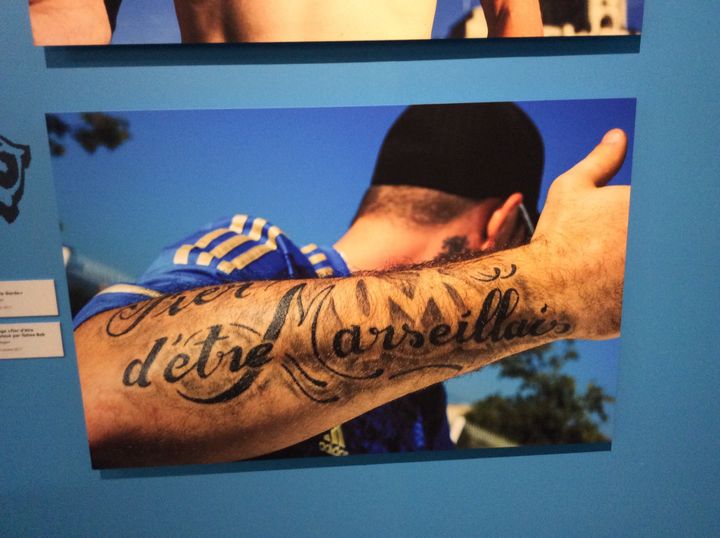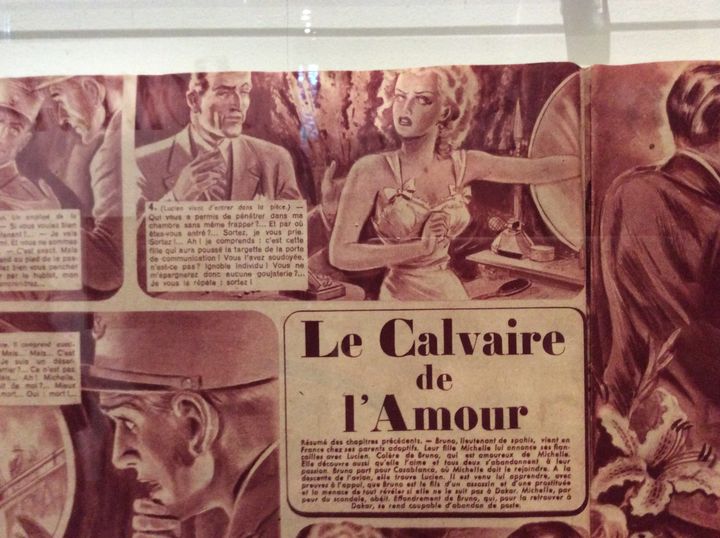
Movie blond...
If sex abuse pulses relentlessly across the American airwaves this fall, lust, longing and betrayal have captured the south of France at its heart in Marseille and surrounding Provence. The love beacon, as so many other provocative expositions in recent years, comes from Marseille’s MuCem, the city’s multi-dimensional museum of Mediterranean life and culture. This fall its curators have mounted two utterly unlikely shows that touch the illusions of passion. The first takes on the history and culture of football (soccer for Americans).The second explores a now disappeared popular medium, Roman Photo, or photo novels of the melodramatic variety.
First, the second. Few non-Italian Americans under 50 have ever seen or heard of a Roman Photo, or Photo Novel, least of all the cultured readers of HuffPost and the Times. Roman Photos appeared first in Italy during the Depression and post-war years. They were essentially hot comic book melodramas, staged like silent movies in sequences of highly produced still photographs.

At their peak in the 1950s, when they had spread to France, Spain and South America, millions upon millions of people—mostly women—bought these weekly papers spun out on cheap newsprint. Nous Deux (both of us) in France claimed 2.5 million subscribers, touching every element of melodramatic passion and disappointment: passion, seduction, la dolce vita, adultery, jealousy, betrayal, abandonment, violence, death and, sometimes, forgiveness and benediction.
When I asked two post-50 French friends about Photo Novels, they lowered their brows, tilted their heads and responded, “They were not permitted in our house.” Or, “My parents found them disgusting.” Nonetheless as late as the mid-1960s, one in three French people read weekly photo books, while even today Nous Deux claims 230,000 circulation. Production techniques were very much like movie sets: Rolleiflex and Hasselblad cameras produced large negatives; the images were printed on high quality paper, breast highlights and muscle tones touched up by hand, they were mounted on card stock, and finally speech bubbles were added.

Just as proper Catholic households forbade Photo Novels to pass their thresholds, other public authorities also denounced them—including all the Communist block countries (Cuba excepted). Christian intellectuals declared them a grave threat to family stability. Pope John XXIII even issued condemnatory encyclical in 1959 labeling them obscene and likely to incite the young to stain their virtue. But they were (and often still are) present in hair stylists shops where romance and morality judgments are rarely proffered.

Desperate to hold onto market share, many Photo Novel publishers turned to porn, horror and Satanic themes. The most notorious, titled Satanik, appeared in Italy in 1966 and featured a mass murderer named “Killing” who specialized in female victims and wore a full-body skeleton costume. Sales boomed both in Italy and France, which led French censors to ban it a year later. The Italians censored it in 1969 after 62 issues had come out.
Touched up torsos and rounded buttocks take up only half the MuCem’s current passion plays. Around a corner and across the main hall you’ll find an equally remarkable XY chromosome dreams and follies in a half dozen rooms dedicated to soccer, entitled Nous Sommes Foot (or We Are Football). While not as uber-hunked as American football players, soccer men and teams hold their own easily as Europe’s and Africa’s testosterone challengers—none more so than the Marseille team, founded over a century ago and consistently at the top of the European ranks.

The Marseille team also scores as one of the world’s most broadly integrated sports teams, an element critical to manly “foot culture.” Since its origins in mid-19th century Britain, “foot” has stood for far more than athletic gaming. Club identity, nationalistic pride, eruptions of hooliganism, massive financial corruption and not least racial division and solidarity have always swirled around the players and their fans. Even Adolph Hitler’s key henchmen, Herman Göring and Joseph Goebbels plunged their racist and anti-semitic programs into the sport, carefully controlling which teams the Nazis would face. Decades later, during the Algerian war of independence, the French were equally careful to curb any contact between official national teams and locals for fear of provoking nationalist violence.

All this might seem like an odd accompaniment to the trashy romances and melodramas of the Photo Books. For Cecille Dumoulin, the MuCem’s outreach and educational specialist, the two shows make a perfect dance. Nous Sommes Foot drew record male visitors, largely local Marseillaises, while she expects Roman Photo to lure mostly women reflecting the core readership historically of the photo novels. All museums always have to address their diverse publics, but Dumoulin goes further. “Photo novels were essentially sentimental ideas of love and fantasy, a projection of the post-war attitudes of the Fifties. In that sense the two expositions aim to explore the dimensions of male fantasies and female fantasies. Maybe it’s a bit of a caricature,” she says, “but it also touches reality even today. The football world still represents a kind of machismo along with big money and racism while the photo novels are, ok, a little old fashioned, a self-enclosed reality that includes a dream of emancipation outside the house, of a more adventurous world than their own.” Dreams of a grander, sweeter, richer life are equally at the heart of the Foot world where players’ peak years rarely pass age 27—but if they’re lucky, the advertising world, especially designers like Dolce & Gabbana, set them up for life.

In short, these dual expos represent the ongoing anthropological aims of the MuCem: to match the interior and exterior imaginations of Mediterranean culture and to pass through the mental sports that divide and unite men and women. Love and its diverse obsessions continue to be high on the coming year’s projects at the MuCem, and indeed across southern France in a coordinated program of exhibits, dance, music and public installations all under the rubric Quel Amour! for which Roman Photo is the winter long kickoff.

Photos of exhibit images by Frank Browning
